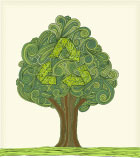TREE TALK
Originally published in Capital on April 24, 2008

Earth Day, Plant a Tree
How about planting a lot of trees?
Thirty eight years ago this week a new holiday of sorts was started: Earth Day. It’s not an official holiday; no one gets the day off and so far as I know they don’t print greeting cards to send to people or have firework displays and BBQ’s or even cake and ice cream. It’s just there. Matter of fact it’s overlooked or even ignored by most people; a lot of folks pat themselves on the back just for recycling their newspapers. But it does have significance; it was perhaps the beginning of the organized environmental movement. What was perhaps most significant was acknowledging the problem, in this case the need for protecting the environment.
The first step in finding a solution to any problem is admitting there is one. And mother earth is having problems. Natural resources are crucial to man’s way of life and very existence. So we need to use them, but we need to do a better job of going about it. And we seem to forget that certain resources are finite, yet continue to use them at alarming rates.
The forest is perhaps the most important natural resource mankind has available. The forest has been taking care of people since the days of Ogg the caveman. Trees can be used for just about every activity you can think of. Trees provide building material, paper, medicines, chemicals, you name it and there’s a tree somewhere involved. Soon, trees will provide biofuels, reducing our dependency on fossil fuels. Trees help save energy too. Shade trees help keep buildings cooler in the summer and block the wind, reducing heating needs in the winter.
The fact is modern living is harsh on the environment. We are no longer the lone hunter gatherer, living in a cave. Our buildings and roads, mining activities and agriculture, just about everything we do all take there toll on the land. The presence of humans in an area generally indicates that pollution of some sort is occurring in one form or the other.
Construction activity creates exposed soil which can lead to nutrients and sediment in the creeks and rivers and watersheds. Roads and parking lots form a large network of impervious surfaces. Subsequently, storm water washes the dirt and pollutants off these surfaces and again it winds up in the creeks and rivers. That vast network of impervious surfaces also prevents the recharge of groundwater, not something that’s good in the long term.
Solutions to most of these problems can for the most part be found as close as the nearest tree. Well, not that tree, but one just like it or similar. Trees can used to hold down soil reducing sediment loading in streams; Planted next to cropland, trees absorb excess nutrients that might otherwise end up in the streams and rivers. Trees are also an integral part of bio retention facilities found on new parking lots that absorb the pollutants and nutrients before the storm water is released into the streams.
Trees are wonderful things that do many things for us, and you know what the best thing is? They are renewable!
We can grow trees to supply us with the products we use and need and not run out. Another good thing about trees is they can grow on land not suitable for crops. Trees do just fine, thank you very much, on the poorest of soils and without using the fertilizers needed for food crops. But they need care and tending too, and sometimes protection, so it’s not a matter of planting a tree and forgetting about it.
One of the slogans used for Earth Day is: Earth Day, Plant a Tree. I say how about planting a lot of trees; we can use them in one way or another.
The Natural Resources Career Conference is accepting applications for the coming summer. The camp runs for a week in late July and is free to County students - grades 9-11. Space is limited so apply soon! For information on the camp and how to apply visit this DNR website: http://www.dnr.state.md.us/forests/nrcareersconf.html.
Or, send an email to the Anne Arundel Board at ForestGreenway@comcast.net
Questions and comments can be directed to
ForestGreenway@comcast.net
Bud Reaves writes Tree Talk for the Anne Arundel County Forest Conservancy
District Board.
Additional Forestry-Related Links
Champion Trees of Anne Arundel County
Big Tree Champions of Maryland
Native Plants for Anne Arundel County
Planting and Care of Your Trees
TREE-MENDOUS MARYLAND
Invasive Species